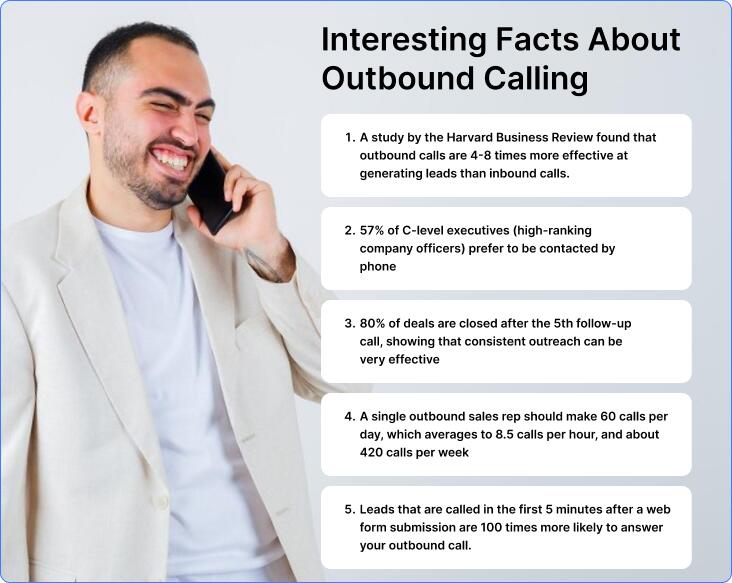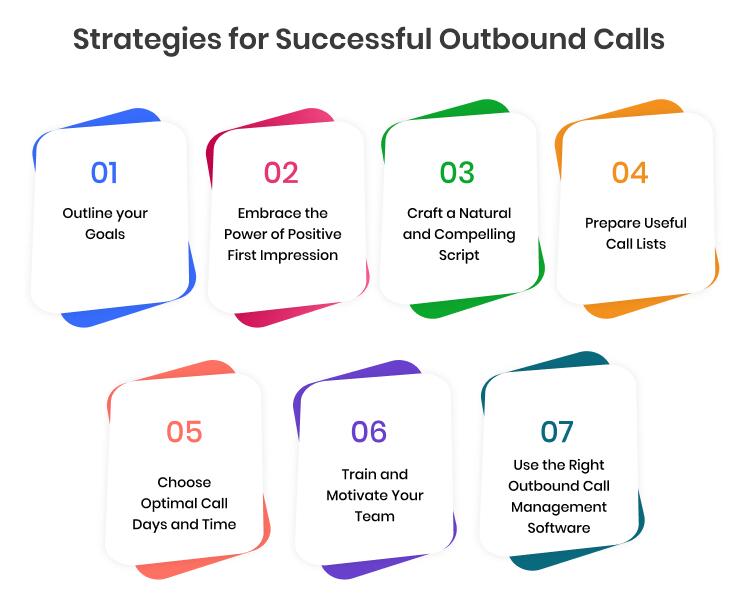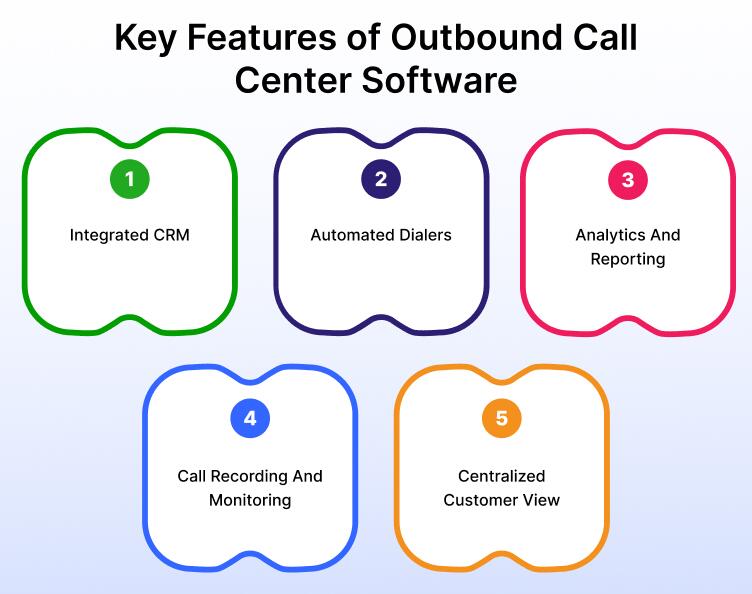
What is an outbound call? Well, we’ve all been there – phone rings, an over-friendly voice on the other end pushing a new service you don’t need. That’s an outbound call in action and no wonder, you hang up immediately in frustration. But here’s the thing: outbound calls can be incredibly valuable for businesses when done right. In the business world, outbound calls are those initiated by a call center agent or sales representative to reach potential customers, promote products, and convert leads.
In Hubspot Research, it has been found that “62% of marketers found success with their outbound marketing efforts.” More specifically, “32% of them see strong lead generation results from outbound tactics.”
Through this post, I’m going to help you learn how to make genuine interactions, not pushy sales pitches when doing outbound calls. We’ll explore outbound call meaning, some practical examples, tips to improve your outbound calling strategy, and the importance of outbound calling software.
What is an Outbound Call?
An outbound call is any call a business makes to potential and existing customers. The ultimate goal behind making outbound calls is usually lead generation, telemarketing, cross-selling/ upselling, market research, appointment setting, follow-ups, and fundraising.
Here are some interesting stats about outbound calling:

Inbound vs Outbound Calls: Key Differences
Understanding the difference between inbound and outbound calls is crucial because both play vital roles in fostering customer relationships, generating leads, and achieving business goals. However, the approach followed by these calling methods is completely different.
Let’s take a look at the key differences between inbound and outbound calls.
Inbound Calls: Here, the customer initiates the call, reaching out to a business or a company for various reasons. The reasons for inbound calling could be customer service inquiries, technical support, placing orders, or general questions.
Outbound Calls: Here, the company or business initiates the call, reaching out to the customer. The reasons for outbound calling are usually sales, lead generation, appointment confirmations, surveys, or follow-ups.
What’s the Goal?
Inbound Call Centers: Such call centers work on the primary goal of resolving customer issues efficiently, providing excellent customer service, and maintaining positive customer relationships. Inbound call center agents have expertise in handling incoming customer inquiries.
Outbound Call Centers: Such call centers focus on making outgoing calls to achieve various goals. For example, sales teams might use outbound calls for lead generation and closing deals. Marketing teams might leverage them for surveys and market research. Customer service teams might use them for follow-up calls or appointment reminders.
What Skills Agents Possess?
Inbound Call Agents: These agents need strong problem-solving skills, active listening skills, and the ability to empathize with customer concerns. They also need to be adaptable to handle unexpected issues.
Outbound Call Agents: These agents need strong communication and persuasion skills to engage potential customers. Outbound call center agents often use scripts to deliver consistent messages to achieve sales targets and closing deals.
What are Customers’ Expectations?
Inbound Calls: Customers initiating inbound calls typically have a specific need or question. Often, they might be frustrated with an issue or seeking assistance to make a purchase decision.
Outbound Calls: Customers receiving outbound calls might not be expecting them. They could be receptive to the call’s purpose, such as a helpful follow-up or a special offer. However, chances are they could also be apprehensive or annoyed by unsolicited calls.
| Feature | Inbound Calls | Outbound Calls |
| Definition | Calls received by an organization or individual. | Calls initiated by an organization or individual. |
| Purpose | Customer service, support, inquiries, orders, etc. | Sales, marketing, follow-ups, surveys, collections, etc. |
| Initiator | Customer or external party. | Organization or individual within the organization. |
| Volume Management | Typically reactive; requires efficient handling of varying call volumes. | Typically proactive; can be planned and scheduled. |
| Technology Used | IVR (Interactive Voice Response), ACD (Automatic Call Distribution), and call queues. | Dialers (manual, preview, predictive, power), CRM systems. |
| Staff Skills | Strong customer service skills, problem-solving, and empathy. | Strong sales skills, persuasion, resilience, and persistence. |
| Call Flow | Usually customer-driven; starts with customer needs or issues. | Organization-driven; starts with a script or campaign objective. |
| Metrics | First Call Resolution (FCR), Average Handle Time (AHT), Customer Satisfaction (CSAT). | Conversion Rate, Calls per Agent, Average Call Duration. |
| Examples | Customer calling a help desk for tech support. | Sales team calling potential clients to pitch products. |
| Training Focus | Product knowledge, service protocols, and troubleshooting. | Sales techniques, objection handling, closing strategies. |
| Challenges | High variability in call types, managing peak times. | Dealing with rejection, maintaining motivation, and compliance with regulations. |
What is a Cold Outbound Call?
Imagine a salesperson making a phone call to a potential customer who has never heard of their company or product. That’s a cold call. There’s no prior connection and no expressed interest from the customer. Although cold calling may appear contentious, a Crunchbase study found that organizations that don’t cold call experienced 42% less growth than those that do.
Example: A software company obtains a list of businesses in their target market. They train a team of sales reps to call these businesses, explain the benefits of their software, and attempt to schedule a demo.
Benefits of Cold Calling
Cold calls are a good way to:
- Reaching New Customers: Cold calls allow companies to connect with potential customers who might not be actively searching for their products.
- Building Relationships: A skilled salesperson can use a cold call to introduce themselves, and their company, and potentially build a rapport that leads to future business.
Challenges of Cold Calling
- Low Success Rates
Reaching the right person can be difficult. Convincing someone to listen to a pitch about an unknown product is even harder. Cold calls often result in hang-ups or polite but firm rejections.
- Negative Perception
Many people find cold calls intrusive and disruptive. This can damage the company’s image if not handled with professionalism and respect.
What is a Warm Outbound Call?
Here, the salesperson has some prior knowledge about the potential customer, indicating a level of interest. This could be:
- Someone who downloaded a white paper or signed up for a webinar
- A referral from a satisfied customer
- Someone who previously expressed interest in a similar product or service
Example: A marketing automation company tracks leads who repeatedly visit their website and download product brochures. A salesperson from the company then reaches out to these leads to discuss their specific marketing needs and how the company’s software solutions can assist them.
Advantages of Warm Calling
Higher Success Rates
Since there’s some pre-existing interest, warm calls are more likely to lead to positive conversations and potential sales. 73% of business executives would prefer to work with a sales representative referred to them by a mutual connection. (HubSpot)
More Targeted Approach
The salesperson can tailor their pitch to the specific needs and interests of the potential customer, increasing engagement. Sales representatives who use warm call strategies are 51% more likely to meet or exceed their given quotas. (LinkedIn). Moreover, warm calling techniques allowed 31% of B2B salespeople to build deeper connections and relationships with their customers. (Spotio)
| Feature | Cold Outbound Calls | Warm Outbound Calls |
| Definition | Calls made to potential customers with no prior contact. |
Calls made to potential customers who have had some prior contact or interest. |
Lead Status |
Unqualified leads, no prior interaction. |
Qualified leads, some level of interest or interaction established. |
Initiation |
Typically initiated by the company based on prospect lists. |
Initiated based on previous interactions, inquiries, or expressed interest. |
Preparation |
Requires extensive research and data gathering. |
Less extensive research needed; information from previous interactions available. |
Conversion Rate |
Generally lower conversion rates. |
Generally higher conversion rates due to prior interest or engagement. |
Rejection Rate |
Higher likelihood of rejection. |
Lower likelihood of rejection as prospects have shown prior interest. |
Call Objective |
To introduce the product/service and generate interest. |
To follow up, provide additional information, and move closer to a sale. |
Script Style |
More generalized, focused on introducing the company/product. |
More personalized, based on previous interactions and known interests. |
Agent Skills Needed |
Strong persuasion and resilience to handle objections and rejections. |
Good follow-up skills, ability to build on previous interactions and trust. |
Response Time |
Typically longer as prospects are not expecting the call. |
Typically shorter as prospects are familiar with the company/product. |
Follow-Up |
Often requires multiple follow-ups to build interest. |
Fewer follow-ups needed; the goal is to capitalize on existing interest. |
Examples |
Calling a purchased list of potential customers. |
Following up on a webinar attendee list or a contact form submission. |
Benefits of Outbound Calling

These days, communication channels are overflowing with emails, texts, social media messages, and a lot more. Making outbound calls might seem like a relic of the past. However, one should not underestimate the power of a well-placed phone call. When implemented strategically, outbound calls can be a game-changer for businesses looking to:
Generate Qualified Leads and Boost Business Sales
With access to insightful data and leveraging captivating scripts, salespersons or agents can connect with potential customers who align perfectly with the business’s ideal buyer profile.
Example: A software company uses outbound calls to contact businesses that have shown interest in their product through website visits. By providing a personalized demo over the phone, they convert a significant number of these leads into paying customers.
Interesting Insight: Outbound calls allow for real-time interaction and personalized conversations, unlike mass emails that often get buried in inboxes. This human touch can significantly increase lead qualification compared to automated marketing tactics.
Build Stronger Customer Relationships and Enhance Brand Loyalty
Outbound calls are often thought of as a sales tool, but that’s just one facet! Outbound calls are also about nurturing existing relationships. You can think of it as a friendly check-in to see if customers are happy, address any concerns, and offer additional value.
Example: An online furniture retailer uses outbound calling services to follow up with recent customers who purchased a couch. The call center agents inquire about their satisfaction, offer helpful tips on furniture care, and showcase complementary furniture pieces that might enhance their living space.
Interesting Insight: A proactive customer service approach signifies that your business cares about its customers’ experience beyond the initial sale. This can foster brand loyalty and encourage repeat business.
Conduct Effective Market Research and Gain Valuable Customer Feedback
Outbound calling services are a powerful tool for gathering valuable customer insights. Businesses can conduct targeted surveys and polls by making outbound calls and collecting in-depth feedback on customer preferences, product satisfaction, and market trends.
Example: A mobile phone manufacturer uses outbound calls to a selected group of customers who recently purchased a new phone model. The call center agents ask questions about their experience with the phone’s features, design, and overall performance.
Interesting Insight: Directly contacting customers allows for more detailed feedback compared to online surveys.
Increase Brand Awareness and Generate Buzz Around New Products or Services
Businesses can leverage a well-timed outbound calling strategy to create a buzz around their latest products, promotions, and offerings.
Example: A local salon leverages outbound calls to inform its customers about a limited-time deal on haircuts.
Interesting Insight: Targeted outbound calls can be a cost-effective way to reach a specific audience and generate interest in new products or services compared to broader advertising campaigns.
Strategies for Successful Outbound Calls
How do you make an outbound call effective? Let’s find out the answer!
The average number of calls required to reach a prospect has increased over the years. In 2007, it took about 3.68 calls to reach a prospect, whereas today, it takes an average of 8 calls. This trend suggests that prospects are harder to reach or are less responsive to initial contact attempts compared to the past.

It is therefore imperative to follow some tried and tested strategies for successful outbound calling. Here you go!
Outline your Goals
Before you start with your outbound call strategy, it is important to define your objectives very clearly. What’s the purpose of your outbound calls? Are you aiming to:
- Schedule appointments?
- Generate sales?
- Encourage further action from prospects (e.g., downloading a white paper)?
Having your objectives clear helps tailor your approach.
Embrace the Power of Positive First Impression
Remember the saying, “You never get a second chance to make a first impression.” Make sure your outbound calls start with a professional yet friendly introduction. It’s a good idea to state your name (the caller’s name), your company’s or business’s name, and the purpose of your call. Successful calls include 65% more “we” statements, as opposed to “I” or “you” statements. (Gong.io)
Also, use upbeat language throughout the call. Outbound sales representatives who use definitive words (absolutely, definitely, certainly) are 5 times more successful than representatives who do not (Ulan). Moreover, 93% of your potential success can be attributed to your tone of voice during your outbound call. (Close)
Also, ensure that you don’t just talk, but also actively listen to the customer’s concerns and doubts.
Craft a Natural and Compelling Script

There’s no harm in using a script for your outbound calls as long as it doesn’t sound robotic. Your script should clearly communicate the value proposition of your product or service. Keep the tone of your script natural and conversational.
Also, be prepared to tailor your pitch based on the customer’s responses to match their unique needs. A representative who asks, “Is now a bad time?” is 40% less likely to book a further meeting or call than one who doesn’t ask this question. (Gong.io)
Outbound Call Script Example
Customer Satisfaction Survey Script
[Agent]: Hello, may I speak with [Customer’s Name], please?
[Customer]: This is [Customer’s Name].
[Agent]: Hi [Customer’s Name], this is [Agent Name] from [Company Name]. We are conducting a quick survey to improve our services, and your feedback would be very valuable to us. Do you have a few minutes to answer some questions?
[Customer]: Sure, I have a few minutes.
[Agent]: Great, thank you! First, how satisfied are you with our service on a scale of 1 to 10?
[Customer]: Response given
[Agent]: Thank you. Can you tell me what you like most about our service? And is there anything you feel we could improve?
[Customer]: Response given
[Agent]: Thank you so much for your time and valuable feedback, [Customer’s Name]. We really appreciate it. If you have any further comments or need assistance, please don’t hesitate to contact us. Have a great day!
Prepare Useful Call Lists
Certainly, you don’t want to waste time with generic calls. Therefore, it is a good idea to segment your call lists based on demographics, purchase history, and other factors. As you begin with the process of creating call lists for your business’s outbound calling, make sure:
- You focus on qualified leads only
- Keep only those leads that are likely to benefit from your offerings
- Empower your agents with comprehensive knowledge such as the location, industry, and potential pain points of the prospects
Choose Optimal Call Days and Time
Strategically choose days and time zones to maximize the effectiveness of your outbound calls. Wednesday statistically tends to be the best day to receive outbound calls, while Mondays and Fridays should be avoided if possible (source).
Also, consider the time zones of your audience. Aim for calls during their mid-morning (around 10-11 am) or late afternoon (around 4-5 pm) when they’re more likely to be available and receptive.
Train and Motivate Your Team
While you implement all the tools and techniques to maximize the effectiveness of your outbound call campaigns, don’t forget your real players – your team members, and your agents. These are the people who are going to interact directly with your prospects.
With the right knowledge and skills, they can help your business achieve its goals. Here are some steps you can take:
- Make sure your agents have a deep understanding of your products and services.
- You can periodically conduct sessions that specifically cover product features, benefits, and pricing structures.
- Role-playing exercises are an excellent way to enable agents to practice outbound calling by creating real-world scenarios.
- Ensure agents are familiar with using the call center software and all the tools that can benefit the outbound calling process.
Use the Right Outbound Call Management Software
Invest in quality technology such as reliable call center software packed with features for better outbound call management. Ensure the system offers call recording, call analytics, and automated follow-up tools. I will explain more about this later in this post, so keep reading.
How to Measure Outbound Call Effectiveness?
Measuring the success of your outbound call center means understanding the impact of your calls on achieving your business goals.
Get a Clear Picture of Your KPIs
Whether your goal is to generate leads, increase sales, or improve customer satisfaction, some of the essential KPIs for an outbound call center are:
Number of Outbound Calls: Track the daily volume of outbound calls made by your agents. This provides a basic understanding of call center activity.
Conversion Rate: This measures the percentage of calls that result in a desired outcome, such as a sale, appointment booking, or survey completion.
First Call Close Rate: This measures the percentage of calls that achieve the desired outcome on the initial call, showcasing agent efficiency and communication skills.
Average Handle Time (AHT): This measures the average duration of a call, including agent talk time and hold time. While a certain amount of talk time is necessary, an excessively high AHT might indicate inefficiencies or a need for more concise communication.
How to Choose the Best Outbound Call Center Software?

Now let’s come to the practical part – choosing the right outbound call center software. While there are so many options available out there, how do you ensure that you choose the most appropriate one? First, you need to ensure the presence of some essential features in your outbound call center software.
Centralized Customer View
It is essential for an outbound call center software to provide a centralized view of customer interactions i.e. complete customer history by consolidating data from various customer touchpoints. This helps agents provide customers with more personalized and quick service as they can manage customer interactions across multiple channels from a single space.
Integrated CRM
An integrated CRM connects your call center software with other business systems, such as marketing automation tools or e-commerce platforms. This allows for a two-way flow of data, ensuring all your customer interactions are tracked and reflected across different departments.
Smart Dialing Functionality
Automatic dialers or power dialers are a popular choice in call center setups to free up agents from manual dialing and maximize their talk time. Power dialers dial the numbers automatically and connect a live agent only when a prospect picks up. You can choose from progressive, preview, or predictive dialers based on your specific business needs.
Call Monitoring and Recording
Real-time call monitoring is a valuable tool for call center managers as they can monitor the performance of the agents live. Also, call recordings can be used to review and understand customer pain points, preferences, and the ability of the agents to tackle customer queries. Managers gain useful insights along with areas that need improvement.
Analytics and Reporting
Outbound call center solutions with analytics and reporting capabilities offer managers concrete data to make strategic decisions. Managers can also compare the performance of their marketing efforts via phone to other channels such as email.
Summary: What is an Outbound Call?
Sales reps make an average of 45 cold calls per day, and the number of daily quality conversations is 5.1 calls. (The Bridge Group). “Calls with a good talk-listen ratio (46% talking, 54% listening) and a focus on value for the customer tend to be more successful,” advises writecream.com.
Outbound calls have the potential to nurture leads, close deals, and strengthen customer relationships, but achieving success requires a strategic approach. By blending persistence with personalization, leveraging technology, and utilizing data analysis, you can transform outbound calls into a valuable source of customer engagement and conversions.




























